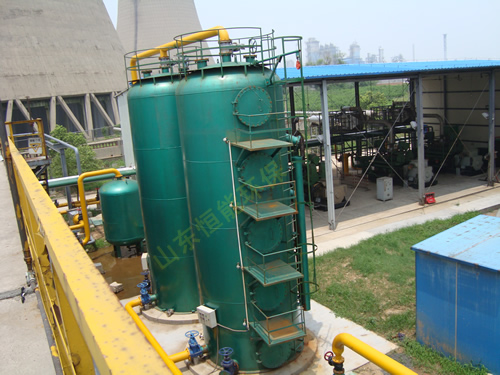欢迎进入山东恒能环保能源设备有限公司
欢迎进入山东恒能环保能源设备有限公司
沼气作为一种清洁能源,其主要成分是甲烷,但通常含有 0.5%-3% 的硫化氢,这种气体具有强烈腐蚀性和毒性,不仅会腐蚀发电设备、管道,还会在燃烧时生成二氧化硫污染环境。沼气脱硫工艺通过物理、化学或生物方法去除硫化氢,是沼气资源化利用的关键环节,不同工艺适用于不同的硫化氢浓度、处理规模及运行条件,需根据实际情况选择适配方案。
Biogas, as a clean energy source, is mainly composed of methane, but usually contains 0.5% -3% hydrogen sulfide. This gas has strong corrosiveness and toxicity, not only corroding power generation equipment and pipelines, but also generating sulfur dioxide during combustion, polluting the environment. The biogas desulfurization process removes hydrogen sulfide through physical, chemical, or biological methods, which is a key link in the resource utilization of biogas. Different processes are suitable for different hydrogen sulfide concentrations, treatment scales, and operating conditions, and suitable solutions need to be selected according to the actual situation.
干法脱硫是中小型沼气工程常用的工艺,利用固体脱硫剂的吸附或化学反应去除硫化氢。工艺核心是脱硫塔,塔内填充脱硫剂(如氧化铁、活性炭),沼气从塔底进入,与脱硫剂充分接触,硫化氢被吸附或反应生成无害物质。氧化铁脱硫剂通过化学作用去除硫化氢,氧化铁与硫化氢反应生成硫化铁,当脱硫剂颜色从棕红色变为黑色时,表明已接近饱和,需更换或再生(通过通入空气将硫化铁氧化为氧化铁和单质硫)。活性炭脱硫则依靠物理吸附,适合低浓度硫化氢(低于 1000ppm)的处理,吸附饱和后需高温再生,适合对气体纯度要求高的场景(如沼气提纯制 CNG)。干法脱硫设备简单、投资低,单塔处理量通常为 5-50 立方米 / 小时,适合农村户用沼气池或小型养殖场,但其脱硫剂更换频繁,运行成本随处理量增加而上升。
Dry desulfurization is a commonly used process in small and medium-sized biogas projects, which utilizes the adsorption or chemical reaction of solid desulfurizers to remove hydrogen sulfide. The core of the process is the desulfurization tower, which is filled with desulfurizing agents (such as iron oxide and activated carbon). Biogas enters from the bottom of the tower and comes into full contact with the desulfurizer. Hydrogen sulfide is adsorbed or reacted to produce harmless substances. Iron oxide desulfurizer removes hydrogen sulfide through chemical reactions. Iron oxide reacts with hydrogen sulfide to form iron sulfide. When the color of the desulfurizer changes from brownish red to black, it indicates that it is close to saturation and needs to be replaced or regenerated (by introducing air to oxidize iron sulfide into iron oxide and elemental sulfur). Activated carbon desulfurization relies on physical adsorption and is suitable for treating low concentrations of hydrogen sulfide (below 1000ppm). After adsorption saturation, high-temperature regeneration is required, making it suitable for scenarios with high gas purity requirements (such as biogas purification to produce CNG). Dry desulfurization equipment is simple and requires low investment. The processing capacity of a single tower is usually 5-50 cubic meters per hour, which is suitable for rural household biogas digesters or small livestock farms. However, the desulfurizer is frequently replaced, and the operating cost increases with the increase of processing capacity.

湿法脱硫适用于中高浓度硫化氢(1000ppm 以上)的大规模处理,通过液体吸收剂与硫化氢反应实现脱除。常用的湿法脱硫工艺有化学吸收法和物理吸收法,化学吸收法(如胺法、碱液法)中,碱液(如氢氧化钠溶液)与硫化氢反应生成硫化钠,溶液达到一定浓度后需再生(如通入空气氧化生成硫单质),碱液可循环使用,适合硫化氢浓度波动大的场景(如垃圾填埋场沼气)。物理吸收法(如低温甲醇洗法)利用有机溶剂在高压低温下对硫化氢的高溶解度实现分离,适合高压力下的沼气处理(如沼气发电的增压环节),溶剂再生能耗较低,但设备投资较高。湿法脱硫可连续运行,单套系统处理量可达 100-1000 立方米 / 小时,适合大型污水处理厂、工业沼气工程,其脱硫效率可达 99% 以上,能将硫化氢浓度降至 20ppm 以下。
Wet desulfurization is suitable for large-scale treatment of medium to high concentrations of hydrogen sulfide (above 1000ppm), achieved through the reaction of liquid absorbents with hydrogen sulfide. The commonly used wet desulfurization processes include chemical absorption method and physical absorption method. In chemical absorption method (such as amine method and alkali solution method), alkali solution (such as sodium hydroxide solution) reacts with hydrogen sulfide to generate sodium sulfide. After the solution reaches a certain concentration, it needs to be regenerated (such as oxidizing with air to generate sulfur monomer). The alkali solution can be recycled and is suitable for scenarios with large fluctuations in hydrogen sulfide concentration (such as landfill biogas). The physical absorption method (such as low-temperature methanol washing method) uses organic solvents to separate hydrogen sulfide with high solubility at high pressure and low temperature, which is suitable for high-pressure biogas treatment (such as the boosting process of biogas power generation). The energy consumption of solvent regeneration is low, but the equipment investment is high. Wet desulfurization can operate continuously, with a single system processing capacity of 100-1000 cubic meters per hour, suitable for large-scale sewage treatment plants and industrial biogas projects. Its desulfurization efficiency can reach over 99%, and it can reduce hydrogen sulfide concentration to below 20ppm.
生物脱硫是一种环保高效的新工艺,利用微生物的代谢作用将硫化氢转化为无害物质。工艺系统由生物反应器、营养液供给装置组成,反应器内的脱硫细菌(如硫氧化菌)在有氧条件下,以硫化氢为能源,将其氧化为硫酸根或单质硫,反应条件温和(温度 20-35℃,pH 值 6-8),无需高温高压。生物脱硫适合中低浓度硫化氢(500-5000ppm)的处理,尤其适合与农业沼气工程结合,因反应产生的硫酸根可作为农作物肥料的补充,实现资源循环。其运行成本低(主要消耗少量电能和营养液),无二次污染,但启动周期长(需 1-2 个月培养微生物),且对温度、pH 值变化敏感,适合稳定运行的中型沼气工程(处理量 20-200 立方米 / 小时)。
Biological desulfurization is an environmentally friendly and efficient new process that utilizes the metabolic action of microorganisms to convert hydrogen sulfide into harmless substances. The process system consists of a bioreactor and a nutrient solution supply device. The desulfurization bacteria (such as sulfur oxidizing bacteria) in the reactor use hydrogen sulfide as energy under aerobic conditions to oxidize it into sulfate ions or elemental sulfur. The reaction conditions are mild (temperature 20-35 ℃, pH 6-8), and do not require high temperature and high pressure. Biological desulfurization is suitable for the treatment of low to medium concentrations of hydrogen sulfide (500-5000ppm), especially when combined with agricultural biogas engineering. The sulfate ions produced by the reaction can be used as a supplement to crop fertilizers, achieving resource recycling. It has low operating costs (mainly consuming a small amount of electricity and nutrient solution), no secondary pollution, but a long start-up cycle (requiring 1-2 months to cultivate microorganisms), and is sensitive to temperature and pH changes, suitable for stable operation of medium-sized biogas projects (processing capacity of 20-200 cubic meters/hour).
工艺选择需综合考量硫化氢浓度、处理规模、运行成本及环保要求。低浓度、小规模场景优先选择干法脱硫(如农村沼气);中高浓度、大规模场景适合湿法脱硫(如工业沼气);对环保要求高、运行稳定的场景可采用生物脱硫(如生态农场沼气)。无论选择哪种工艺,都需配套硫化氢在线监测装置,实时监控出口硫化氢浓度(通常要求低于 200ppm),确保后续设备安全运行。随着沼气资源化利用的推广,脱硫工艺正朝着高效化、低能耗、智能化方向发展(如干法脱硫剂自动更换系统、湿法脱硫液再生效率优化),进一步提升沼气利用的经济性与环保性。
The process selection needs to comprehensively consider the concentration of hydrogen sulfide, treatment scale, operating costs, and environmental requirements. Priority should be given to dry desulfurization in low concentration and small-scale scenarios (such as rural biogas); Suitable for wet desulfurization in medium to high concentration and large-scale scenarios (such as industrial biogas); For scenarios with high environmental requirements and stable operation, biological desulfurization (such as ecological farm biogas) can be used. Regardless of which process is chosen, a hydrogen sulfide online monitoring device must be installed to monitor the concentration of hydrogen sulfide at the outlet in real time (usually required to be below 200ppm), ensuring the safe operation of subsequent equipment. With the promotion of biogas resource utilization, desulfurization processes are developing towards high efficiency, low energy consumption, and intelligence (such as automatic replacement systems for dry desulfurizers and optimization of wet desulfurization liquid regeneration efficiency), further improving the economic and environmental friendliness of biogas utilization.
本文由沼气脱硫友情奉献.更多有关的知识请点击:https://www.hneee.net我们将会对您提出的疑问进行详细的解答,欢迎您登录网站留言.
This article is a friendly contribution from biogas purification For more information, please click: https://www.hneee.net We will provide detailed answers to your questions. You are welcome to log in to our website and leave a message